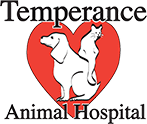Food Does NOT Always Equate to Love!
We as humans have elevated eating to a social function. We bond as families around the dinner table, we catch up with old friends over pizza and beer and we wine and dine those we wish to impress. This tradition can become dangerous, though, if we extend the same mentality to our four-legged companions. When it comes to our dogs and cats we must remind ourselves that food does not equate to love, but attention does equate to love. No matter what message the television commercials wish you to believe, our dogs and cats can contentedly live on a healthy diet of a balanced and nutritious pet food and likely would much prefer extra time spent with you than a plate of food.
Obesity is a leading cause of illness and chronic disease in our pets… but that is a separate topic all in itself. In this blog entry we want to discuss foods that can actually be dangerous to your pet.
Chocolate and other Methylxanthines (such as coffees, teas and caffeinated sodas) are fairly well known animal food toxins. The active ingredient in chocolate is Theobromine and a good rule of thumb to remember is that the darker the chocolate–the more toxic. Unsweetened baker’s chocolate is one of the worst! Clinical signs usually begin 1-4 hours after ingestion and can be compared to a person after a dozen or so espressos: agitated, restless, muscle tremors and fast heart rate. With even higher levels of ingestion seizures, arrhythmias (irregular heartbeats), coma and even death can occur without
treatment!
Onions/Garlic/Chives/Leeks carry a concern for causing hemolytic anemia. This food group contains sulfoxide and disulfide compounds that have been shown to cause oxidative damage to Red Blood Cells. This oxidative damage in effect causes the Red Blood Cells to break apart inside the vessels leading to anemia and the associated weakness and organ system damage caused from lack of oxygen supply. Raw, crushed, cooked and dried forms all seem to pose a threat. Cats are more sensitive than dogs, although exposures are more commonly reported in dogs. Perhaps our felines have a more discerning palate?
Grapes and Raisins are a “newer” toxicity that we have learned about in dogs. By a mechanism that has yet to be identified, eating grapes and/or raisins has the risk of causing Acute Kidney Failure in dogs. There does not appear to be a dose dependent response and previous exposure to grapes/raisins does not seem alleviate the risk! So even if your dog has enjoyed snacking on this otherwise yummy fruit all his life… it is not wise to continue this practice any longer.
An unusual toxicity to discuss is that of Macadamia Nuts in dogs. By yet another unknown pathway, this exotic treat can cause clinical signs within 6-24 hours of ingestion. Dogs may present with weakness (especially of the rear limbs), ataxia (incoordination), tremors, hyperthermia, joint pain and stiffness. Treatment includes supportive care for 24 hours and almost all of the cases fully resolve.
Xylitol is probably the most recently discovered emerging threat to our pets. Xylitol is a sugar substitute used as a sweetener in an increasing number of sugar-free gums, candies, baked goods and other products. It causes a dose-related release of insulin from the pancreas which can result in a dramatic drop in blood glucose (sugar) levels. It is a fairly potent product and only small amounts of the sweetener are needed to cause problems. Occasionally ingestion has also been linked to Acute Hepatic Necrosis (liver damage). Clinical signs (related to the rapidly declining levels of blood sugar) begin within minutes up to 12 hours after ingestion and include: vomiting, lethargy, weakness, collapse and seizures. Supportive care is needed for survival. Patients are started on IV fluids supplemented with Dextrose (a glucose replacement) for 12-24 hours until the insulin surge has waned and the patient is able to maintain normal blood sugar levels again. Monitoring of potassium levels and treatment for liver damage may also be required.
Avocados are frequently found on lists of harmful foods and may actually be harmful to some birds and rabbits. At this point, however, they do not seem to carry any danger for dogs and cats.
Finally, although not truly “toxic”… fatty, greasy and/or spicy foods can be troublesome for our pets. These foods can throw off the delicate balance in a dog or cat’s gastro-intestinal tract leading to illness as simple as Gastro-Enteritis or as life threatening as Acute Pancreatitis.
For a full list of Household Hazards, Poisonous Plants and Frequently Asked Poisoning Questions, visit the ASPCA’s Animal Poison Control Center at http://www.aspca.org/pet-care/poison-control/ . With all of the safe and healthy options available as food sources for our dogs and cats hopefully the items on this list should not be too difficult to avoid? Next time we will discuss how to navigate all of the pet food choices that are out there and make an educated choice of diet for your dog or cat.
